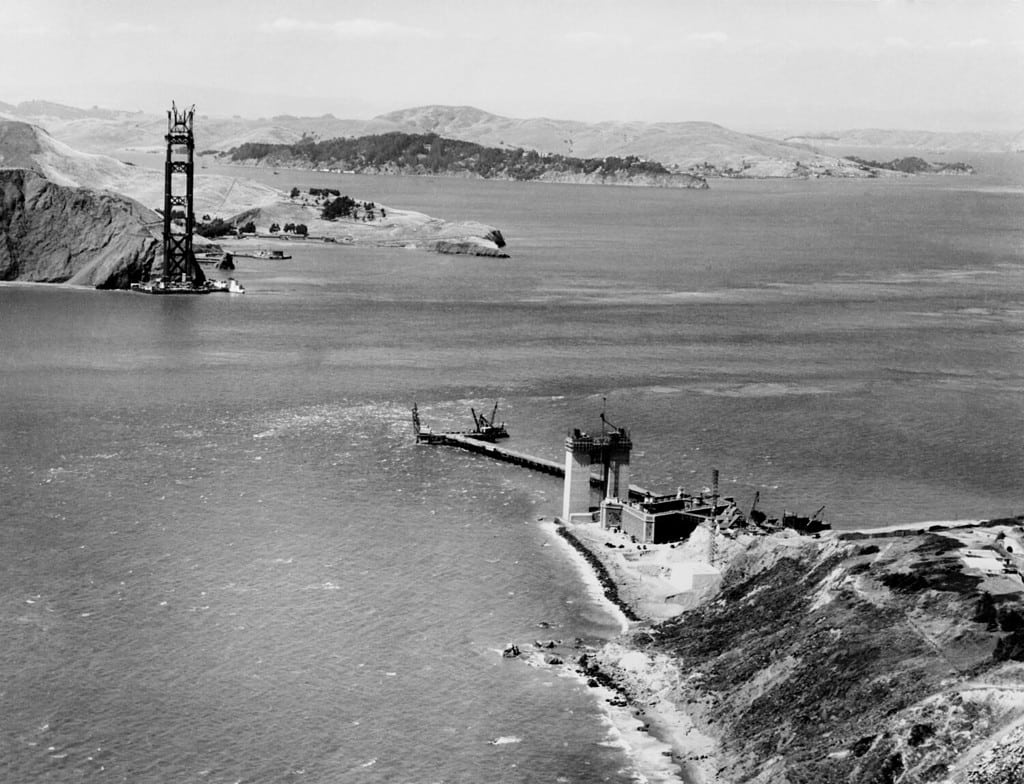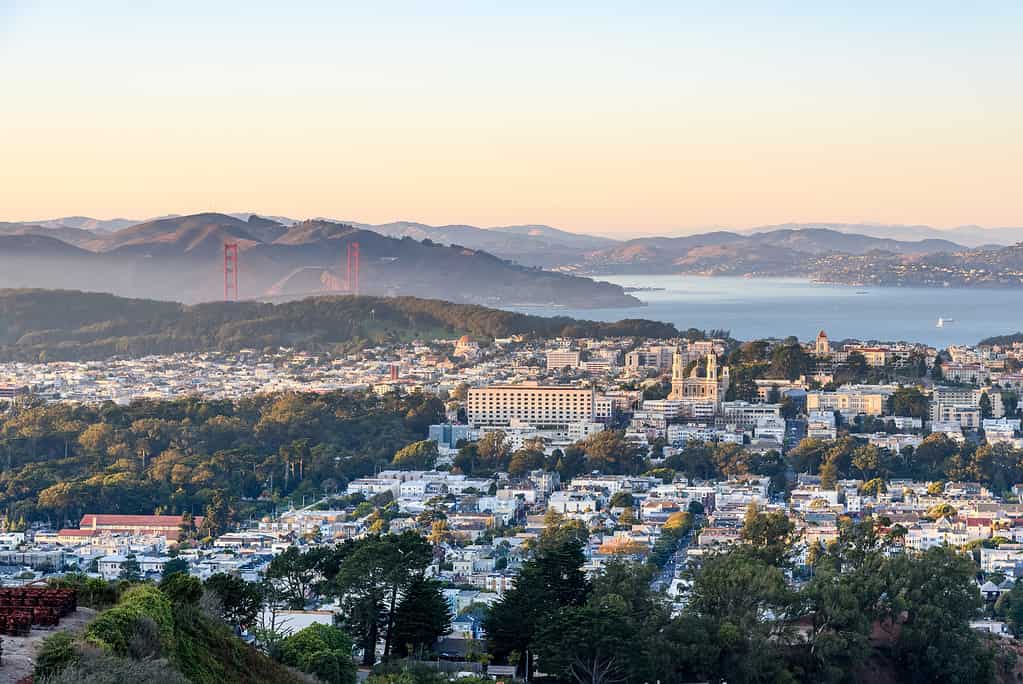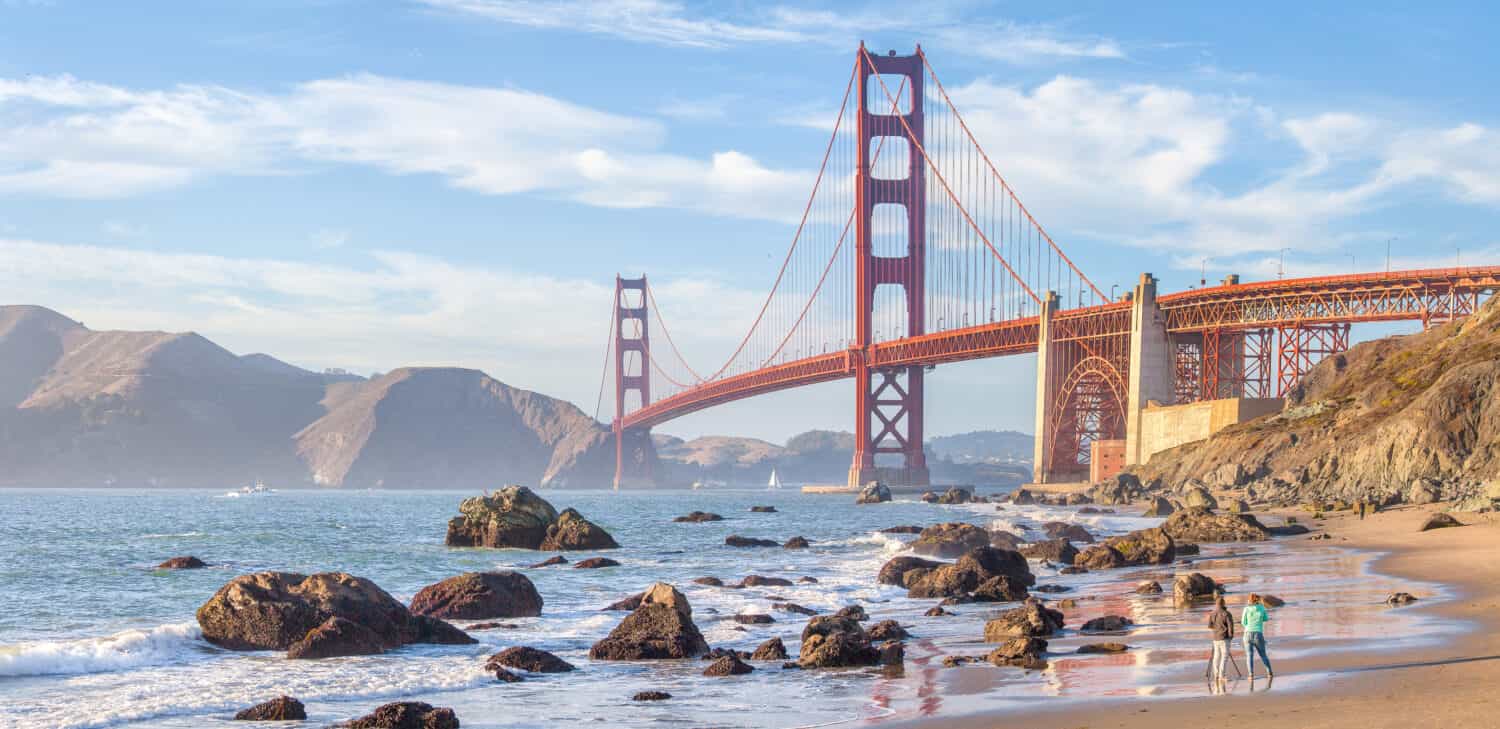The Golden Gate Bridge is arguably the most famous bridge in the world. It is located in San Francisco, which is one of the most famous cities in the world. Visitors from all over flock to the Bay Area to see the majestic bridge up close. Many cross the bridge by foot or by car just to say they did.
People post selfies with the bridge in the background and many of them have no idea how and why the Golden Gate Bridge was built in the first place. Most people don’t know the history behind the bridge, and how, more than 80 years later, it has become a symbol of San Francisco and America.
Let’s explore how and why the Golden Gate Bridge was built. We’ll also give you some information on the wildlife in the area, and some things to do in San Francisco.
Location of the Golden Gate Bridge

More than 1,400 people have died from jumping the Golden Gate into the San Francisco Bay.
©Francesco Carucci/Shutterstock.com
Where is the Golden Gate Bridge, you ask? It’s located in San Francisco, but of course, we already know that. And if you’re in the city, you can see it from different locations. The Golden Gate Bridge’s exact location is at the tip of the San Francisco Peninsula.
The bridge links both U.S. Route 101 and California State Route 1 across the strait into Marin County. The start of the bridge, on the San Francisco side, is the site of Presidio Park. You can find many sites at Presidio Park, like the Walt Disney Family Museum, the Palace of Fine Arts, the Presidio Golf Course, and many more.
Traffic Across the Bridge
The Golden Gate Bridge is accessible by car, as it has six lanes. There is a movable median barrier that is moved depending on the traffic during rush hour in the mornings or evenings. Usually, mornings have four lanes going south into the city, and afternoons have four lanes going north to Marin County. The rest of the time and on weekends, the median is placed in the center with three lanes going in each direction. More than 112,000 vehicles cross the Golden Gate Bridge every day.
There is also a pedestrian walkway on the eastern side of the bridge during certain hours of the day and evening. There is also a bicycle lane on both the eastern and western sides of the bridge, but the bicycle lane on the western side is used only when there are no pedestrians on the eastern side.
History of the Golden Gate Bridge

The Golden Gate Bridge’s painted color, called international orange, was specifically chosen for the bridge for it to stand out amongst the fog and its surroundings.
©Everett Collection/Shutterstock.com
Even before the Gold Rush when people from all over the US flocked to the San Francisco Bay Area, the city of San Francisco already was an established major city. There was a regular ferry service between San Francisco and Marin County. By the early 1930s, it was the largest ferry service in the world and the ride took only 20 minutes.
Because San Francisco was a major city, many people in the area hoped for a bridge that would connect the city to Marin County without having to go around the bay. Experts discouraged this movement because they said construction would be a nightmare as the winds would make it difficult to build. Eventually, the idea of a bridge gained traction, but it took nearly two decades for the construction to happen.
Construction
The construction would cost more than $400 million in today’s dollars, which was extremely expensive. Irving Morrow was chosen as the architect and the engineering design was headed by Joseph Strauss, Charles Ellis, and Leon Solomon Moisseiff. The bridge was modeled in an Art Deco design and it was decided that it would be a suspension bridge.
The financing of the Golden Gate Bridge was approved in 1928, but the Wall Street Crash of 1929 hampered efforts to build the bridge and it wasn’t until Amadeo Giannini bought bonds from a multi-country vote in 1930 that the bridge was able to start construction.
Construction started on January 5, 1933. It took four years to complete and the bridge opened to the public on May 27, 1937. A week-long celebration followed and even an official song, “There’s a Silver Moon on the Golden Gate,” was chosen to commemorate the event.
The Bridge’s Structure
When it was built, The Golden Gate Bridge was the longest suspension bridge in the world, but that record has since been surpassed. It was also the tallest bridge in terms of clearance from the water, but that record was surpassed in 1993.
The bridge saw some retrofitting in the mid-1950s after it was discovered the bridge swayed from intense winds, and has had several retrofitting throughout the years to make it safer and sturdier. There’s also a suicide hotline box to deter from people jumping to their deaths and recently, they added suicide nets on both sides of the bridge.
Wildlife and Nature Around the Bridge

The Golden Gate Bridge has seen a lot of history in its 80+ years, especially with over 2 billion cars that have crossed it.
©Pung/Shutterstock.com
Nature and wildlife are abundant in the waters below the bridge, as well as in the areas in the northern and southern portions of the bridge. In the waters of San Francisco Bay, you can spot whales, as well as sea lions and harbor seals.
At Presidio Park, which is where the Golden Gate’s southern part sits, you can find an array of animals. From amphibians to reptiles, black-tailed deer to spotted owls, if you take a walk in the park, you may be able to spot them. Just watch out for the San Francisco garter snake!
Things to Do in San Francisco

The Golden Gate Bridge is the most photographed bridge in the entire world.
©AlbertPego/iStock via Getty Images
San Francisco is a world-class city with a myriad of things to do. You can visit three, four, or five times and still have things to do that are new and exciting. But let’s start with the basics.
Hitting the tourist areas is a good idea to ensure you see those famous landmarks. Go to Fisherman’s Wharf to eat clam chowder soup and see harbor seals or sea lions in the rocks near the bay. You have to go to Chinatown and eat delicious Chinese food.
San Francisco’s Chinatown is one of the largest in the U.S. Make sure you swing by Golden Gate Park, one of the largest city parks in the country. There you will be able to relax, exercise, and even be one in nature. There are also a few miles of beaches in San Francisco so you have some fun in the sun!
If you go north and you like wine, Napa Valley is for you. Take the Golden Gate Bridge to Marin County and then head a bit east. The wine country there is beautiful and world-famous. California wine is one of the best in the country and even the world.
Fast Facts About San Francisco
- Population: 808,437
- Area: 239.89 square miles
- State: California
- Incorporated: April 15, 1850
- Named For: Saint Francis of Assisi
- Mayor: London Breed
- Board of Supervisors President: Aaron Peskin
- City animal: Wild parrot (Psittaciformes)
Closing Thoughts
And there you have it, that is the story of how and why the Golden Gate Bridge was built. The Golden Gate Bridge is a cultural symbol for San Francisco and the state of California. The Golden Gate Bridge stands for opportunity and success, for the Californian dream that has encouraged people throughout history. In fact, the 25 de Abril Bridge in Lisbon is painted in the same color as the Golden Gate Bridge. This ensures a deep bond between both cities.
The history of the Golden Gate Bridge is unique and amazing. After more than 80 years, it has stood the test of time. After all, it’s not just a symbol, it’s part of what makes California the Golden State.
Thank you for reading! Have some feedback for us? Contact the AZ Animals editorial team.








